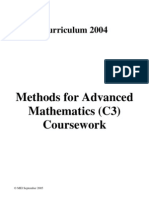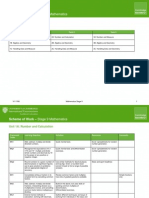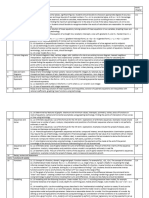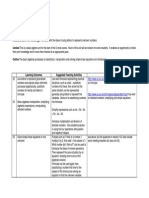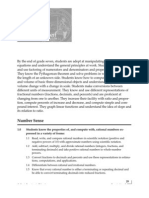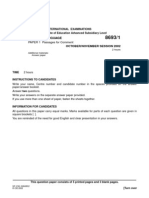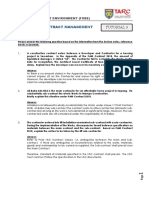0 ratings0% found this document useful (0 votes)
53 views4024 Y04 SW 6
4024 Y04 SW 6
Uploaded by
mstudy123456Unit A6 expands on work with quadratic functions and solving quadratic equations by factorisation. It also extends previous work with linear graphs to representing linear inequalities graphically. Key outcomes covered include factorising quadratic expressions and solving quadratic equations algebraically, as well as drawing graphs of linear inequalities in one or two variables. Suggested teaching activities are provided for each topic.
Copyright:
© All Rights Reserved
Available Formats
Download as PDF, TXT or read online from Scribd
4024 Y04 SW 6
4024 Y04 SW 6
Uploaded by
mstudy1234560 ratings0% found this document useful (0 votes)
53 views6 pagesUnit A6 expands on work with quadratic functions and solving quadratic equations by factorisation. It also extends previous work with linear graphs to representing linear inequalities graphically. Key outcomes covered include factorising quadratic expressions and solving quadratic equations algebraically, as well as drawing graphs of linear inequalities in one or two variables. Suggested teaching activities are provided for each topic.
Original Title
4024_y04_sw_6
Copyright
© © All Rights Reserved
Available Formats
PDF, TXT or read online from Scribd
Share this document
Did you find this document useful?
Is this content inappropriate?
Unit A6 expands on work with quadratic functions and solving quadratic equations by factorisation. It also extends previous work with linear graphs to representing linear inequalities graphically. Key outcomes covered include factorising quadratic expressions and solving quadratic equations algebraically, as well as drawing graphs of linear inequalities in one or two variables. Suggested teaching activities are provided for each topic.
Copyright:
© All Rights Reserved
Available Formats
Download as PDF, TXT or read online from Scribd
Download as pdf or txt
0 ratings0% found this document useful (0 votes)
53 views6 pages4024 Y04 SW 6
4024 Y04 SW 6
Uploaded by
mstudy123456Unit A6 expands on work with quadratic functions and solving quadratic equations by factorisation. It also extends previous work with linear graphs to representing linear inequalities graphically. Key outcomes covered include factorising quadratic expressions and solving quadratic equations algebraically, as well as drawing graphs of linear inequalities in one or two variables. Suggested teaching activities are provided for each topic.
Copyright:
© All Rights Reserved
Available Formats
Download as PDF, TXT or read online from Scribd
Download as pdf or txt
You are on page 1of 6
UNIT A6
Recommended Prior Knowledge Units A1 to A5
Context Work on quadratic functions is expanded, leading to solving a quadratic equation by factorisation. Graphical work is extended to graphing linear
inequalities.
Outline Having factorised simple quadratics in unit A5, students learn to factorise the remaining range of quadratic functions, where possible, and then apply
their knowledge to the solution of quadratic equations. Work done in unit A3 on drawing and interpreting straight line graphs is now applied to representing
linear inequalities graphically.
Learning Outcomes Suggested Teaching Activities Resources
23
25
Factorise expressions of the form
ax + bx + kay + kby; a
2
x
2
b
2
y
2
; a
2
+ 2ab
+ b
2
; ax
2
+ bx + c
Solve quadratic equations by
factorisation.
First revise the work done in A5 on
factorising quadratic expressions with 1 as
the coefficient of x
2
. Then in a similar way
to the work that was done there in
introducing factorisation, first expand and
simplify some quadratic expressions such
as (3x 1)(2x +5) before establishing the
method for factorising such quadratics.
You may wish to combine drawing the
graph of a function such as y =x
2
4x +3
with solving x
2
4x +3 =0 graphically and
factorising x
2
4x +3 as a way in to the
case of solving the equation algebraically
compared with drawing the graph. Show
the students also that the product of two
factors being zero means that one of the
factors must be zero so that they see the
reasoning behind the method of solution by
factorisation. Give the students practice so
that they become proficient in the algebraic
manipulation required.
sections 10.10 and 10.11 of
http://www.ex.ac.uk/cimt/mepres/allgcse/bkb10.pdf
http://www.ilovemaths.com/3quadfactor.htm has some
suitable examples
26 Represent linear inequalities in one or Show how a number line may be used to section 16.1 of
two variables graphically. (Linear
Programming problems are not
included.)
represent in 1-D the solution of an
inequality such as x >6 or 0 x <3, using
an unfilled circle to represent a boundary
which is not included and a filled-in circle to
represent a boundary which is included.
Start representing inequalities in 2-D by
drawing a line such as x =3. Identify the
line as the boundary between the regions x
>3 and x <3. Similarly for lines such as y
=6, y =4x 1, x +2y =6. In particular
identify to the students the possible
methods for determining which region is
which, in the case of sloping lines for
instance seeing which inequality is satisfied
by the origin or another point not on the
line.
Give the students practice in drawing the
graphs of inequalities and in identifying the
inequalities represented on a given graph
[for which they may have to determine the
equation of a straight line, studied in unit
A3].
http://www.ex.ac.uk/cimt/mepres/allgcse/bkc16.pdf
section 16.4 of
http://www.ex.ac.uk/cimt/mepres/allgcse/bkc16.pdf
UNIT D6
Recommended Prior Knowledge Units D1 to D3
Context Work on grouped data studied in D3 is developed further to include the use and interpretation of cumulative frequency diagrams.
Outline The concept of cumulative frequency is introduced, leading on to representing this information in a diagram. The information given by this diagram is
then discussed and used, leading on to comparing distributions.
Learning Outcomes Suggested Teaching Activities Resources
35 Construct and use cumulative frequency
diagrams; estimate the median,
percentiles, quartiles and interquartile
range.
Start with a frequency table for a grouped
distribution and take the opportunity to
revise how to find the mean of such a
distribution, using the mid-points of the
intervals, and how to draw a frequency
polygon to represent the distribution.
Then combine the frequencies for the first
two classes and ask what information is
given by this etc, so helping students to
see that cumulative frequency gives
information about values less than the
upper bound of each class and so the
diagram must be plotted using upper
bounds.
Draw cumulative frequency diagrams and
read information from them, showing how
the median can be obtained directly and
how to interpret the varying steepness of
the graph. Introduce the concepts of
percentiles, quartiles and inter-quartile
range. Give students practice in obtaining
and using these to compare distributions.
http://www.ex.ac.uk/cimt/mepres/allgcse/bkb9.pdf has
cumulative frequency etc at section 9.5
UNIT N6
Recommended Prior Knowledge Units N1, N5
Context Knowledge about indices is applied to using standard form.
Outline The use of standard form to write very large and very small numbers is taught. Students learn to convert numbers to and from this form and to use it
in calculations, both with and without a calculator.
Learning Outcomes Suggested Teaching Activities Resources
8 Use the standard form A 10
n
where n is
a positive or negative integer and 1 A <
10
Ask students to multiply two large numbers
together, such as 2 million and 3.6 million.
Ask them to do this mentally and to write
the result as an ordinary number, then to
do the same calculation on their calculator
and compare the results; similarly for a
division such as 3.6 2 million. Use this
opportunity to define standard form and
discuss the correct notation. Practice
conversion to and from standard form.
Show the students how to use their
calculators to calculate with standard form
and how to use the laws of indices to
simplify standard form calculations without
a calculator.
Astronomy uses large distances and data using stars is a
good source of large numbers. See websites such as
http://www.essex1.com/people/speer/stars.html
Nanotechnology is a good source of data on very small
distances. See websites such as
http://www.sciam.com/article.cfm?chanID=sa002&articleID
=000CE8C4-DC31-1055-973683414B7F0000&catID=7
Section 1.7 of
http://www.ex.ac.uk/cimt/mepres/allgcse/bka1.pdf is about
standard form.
UNIT S6
Recommended Prior Knowledge Units S1 to S5, A1, A5, N4
Context Work on triangles is developed to include similar and congruent triangles and an introduction to trigonometry. Concepts of enlargement and ratios
already met assist in understanding the use of both trigonometrical and similarity ratios.
Outline First, trigonometrical ratios are introduced, leading on to solving right-angled triangle problems including trigonometry and / or Pythagoras theorem.
The focus then moves to similarity, developing an understanding of the ratios there and applying them. Finally, the conditions for congruence for triangles are
established.
Learning Outcomes Suggested Teaching Activities Resources
34 Apply the sine, cosine and tangent ratios
for acute angles to the calculation of a
side or an angle of a right-angled triangle
[angles will be quoted in, and answers
required in, degrees and decimals of a
degree to one decimal place.]
Solve trigonometrical problems in two
dimensions including those involving
angles of elevation and depression and
bearings.
Ask students to draw a right-angled triangle
with an angle of 40 and adjacent side of 2,
4 or 5 cm and to measure the opposite side
and compare the results, (revising their
knowledge of enlargement from unit S5 in
the process), hence finding the opposite
side when the adjacent is 1 cm and
defining this length in cm as tan 40 and
show the length they have drawn is
consistent with this value on the calculator.
Use enlargement to show this is opposite
adjacent for all their triangles drawn.
Repeat the process with one or two other
angles, then show how tangent ratios can
be used to find unknown sides and then
angles in right-angled triangles.
Similarly define cosine and sine ratios and
use all three ratios. Include solving
problems, where the students need to
interpret the situation, sketching a diagram
to show the right-angled triangle needed.
Include also problems requiring the use of
Pythagoras theorem as well as
http://www.catcode.com/trig/index.html has interactive
pages on basic trigonometry
http://www.ex.ac.uk/cimt/mepres/allgcse/bka4.pdf is a
chapter about trigonometry and sections 4.4 to 4.7 are
suitable for this unit, together with work on Pythagoras,
theorem from section 4.3.
trigonometry [studied in unit S3].
27 Solve problems and give simple
explanations involving similarity and
congruence.
Use the work on enlargements in unit S5,
to find unknown sides in similar triangles,
via using the scale factor of enlargement.
Derive the ratios for similar triangles,
relating them to the scale factor and
showing how other ratios can be obtained.
Ask students what information they need to
be given in order to draw a triangle, leading
on to a discussion of the conditions for
congruence. Give students practice in
setting out explanations showing
congruency.
http://www.gcseguide.co.uk/similar_triangles.htm
http://regentsprep.org/Regents/math/similar/Lstrategy.htm
http://regentsprep.org/Regents/math/congruen/Ttriangles.
htm
You might also like
- Born to Be Badger by Shelly Laurenston-pdfread.netDocument340 pagesBorn to Be Badger by Shelly Laurenston-pdfread.netballs 1124No ratings yet
- GEE IE Living in The IT Era SyllabusDocument12 pagesGEE IE Living in The IT Era SyllabusMichael Ramoga100% (5)
- NUET 2022 Mathematics SpecificationDocument9 pagesNUET 2022 Mathematics SpecificationАдина Сагнаева100% (1)
- 4024 Y04 SW 5Document6 pages4024 Y04 SW 5mstudy123456No ratings yet
- Unit A8Document6 pagesUnit A8mstudy123456No ratings yet
- Unit A4: Index - SHTMLDocument9 pagesUnit A4: Index - SHTMLmstudy123456No ratings yet
- Unit A2: Ax + AyDocument7 pagesUnit A2: Ax + Aymstudy123456No ratings yet
- Unit A9Document5 pagesUnit A9mstudy123456No ratings yet
- Unit A2: Ax + AyDocument7 pagesUnit A2: Ax + AyRida SnobNo ratings yet
- Analysis of California Mathematics Standards To Common Core Standards-Grade 5Document20 pagesAnalysis of California Mathematics Standards To Common Core Standards-Grade 5establoid1169No ratings yet
- Trigonometry Teacher's Edition - Common Errors: CK-12 FoundationDocument47 pagesTrigonometry Teacher's Edition - Common Errors: CK-12 FoundationkukumaluXDNo ratings yet
- 0580 Y05 SW 1 2Document3 pages0580 Y05 SW 1 2zurichasNo ratings yet
- C3 Course Work NotesDocument20 pagesC3 Course Work NotesRedouane KhechaNo ratings yet
- Math Grade 5 08 11Document6 pagesMath Grade 5 08 11api-246939068No ratings yet
- Common Core Math Standards Editable Checklistrd GradeDocument171 pagesCommon Core Math Standards Editable Checklistrd GradeJessicaNo ratings yet
- Scheme of Work Maths Stage 9Document16 pagesScheme of Work Maths Stage 9Sue Adames de Velasco50% (2)
- 2003 03 01 MathModelingDocument29 pages2003 03 01 MathModeling'Nabeela MahmoodNo ratings yet
- SL Year Plans DP 2024Document6 pagesSL Year Plans DP 2024Elias GranditsNo ratings yet
- Mathematics Extension 1 Year 12 Topic Guide Trigonometric Functions WordDocument7 pagesMathematics Extension 1 Year 12 Topic Guide Trigonometric Functions WordTony TranNo ratings yet
- 4024 Y04 SW 1Document5 pages4024 Y04 SW 1mstudy123456No ratings yet
- Unit 4 Mathematics For Engineering TechniciansDocument15 pagesUnit 4 Mathematics For Engineering Techniciansdoneill22No ratings yet
- Mathematics Standard 2 Year 12 Topic Guide AlgebraDocument8 pagesMathematics Standard 2 Year 12 Topic Guide AlgebraTony TranNo ratings yet
- U4 Maths For TechniciansDocument9 pagesU4 Maths For TechniciansIllingworth10000% (1)
- UNIT 2 Coordinate Geometry and Calculus (P1) : WWW - Bbc.co - Uk/ Education/asgur U/mathsDocument7 pagesUNIT 2 Coordinate Geometry and Calculus (P1) : WWW - Bbc.co - Uk/ Education/asgur U/mathsFaisal RaoNo ratings yet
- Ap Calculus BC SyllabusDocument15 pagesAp Calculus BC Syllabusapi-306402864No ratings yet
- Math 7 Syllabus 2014-2015Document5 pagesMath 7 Syllabus 2014-2015api-266524097No ratings yet
- CCSSI Math Standards 4Document6 pagesCCSSI Math Standards 4establoid1169No ratings yet
- Foundation Year Program Entrance Tests Mathematics Specification For Nufyp Set 2020Document9 pagesFoundation Year Program Entrance Tests Mathematics Specification For Nufyp Set 2020Даниал ГабдоллаNo ratings yet
- Math Standards Adopted 1997 7Document6 pagesMath Standards Adopted 1997 7establoid1169No ratings yet
- Fourth Math StandardsDocument3 pagesFourth Math Standardsapi-233655908No ratings yet
- Lesson Planning y MX CDocument1 pageLesson Planning y MX CJonathan RobinsonNo ratings yet
- 0580 Straightlinegraphs Teaching Pack v1Document71 pages0580 Straightlinegraphs Teaching Pack v1Karela KhanNo ratings yet
- Curriculum Outcomes For Mathematics 7 2014Document3 pagesCurriculum Outcomes For Mathematics 7 2014api-263902873No ratings yet
- Scheme of Work Qualification: BETC National Diploma in Mechanical Engineering/Year (2), Class (A) Unit No: Unit TitleDocument8 pagesScheme of Work Qualification: BETC National Diploma in Mechanical Engineering/Year (2), Class (A) Unit No: Unit TitleOsama HassanNo ratings yet
- Form 3 Track 3Document9 pagesForm 3 Track 3Justine LiaNo ratings yet
- Igcse Accelerated Mathematics 0580 (Extended 2 Years) Scheme of Work For Year 9 (2011)Document74 pagesIgcse Accelerated Mathematics 0580 (Extended 2 Years) Scheme of Work For Year 9 (2011)Steve JonzieNo ratings yet
- CCSSI Math Standards 5Document6 pagesCCSSI Math Standards 5establoid1169No ratings yet
- Math Grade 4 08 11Document7 pagesMath Grade 4 08 11api-246939068No ratings yet
- Handout: Unit Plan Template Name: Harley Brooks DateDocument30 pagesHandout: Unit Plan Template Name: Harley Brooks Dateapi-239089066No ratings yet
- IGCSE PHYSICS - Addendum To Syllabus (2013)Document36 pagesIGCSE PHYSICS - Addendum To Syllabus (2013)Tanmay KarurNo ratings yet
- CcssDocument10 pagesCcssapi-2372294750% (1)
- MATHS (2)Document16 pagesMATHS (2)vachadevNo ratings yet
- Syllabus 3 AP Calculus BC Course OutlineDocument5 pagesSyllabus 3 AP Calculus BC Course OutlineEbuka Efobi100% (1)
- ESAT Content Specification May2024Document46 pagesESAT Content Specification May2024jackbrowndagodNo ratings yet
- ESATDocument27 pagesESATarjunepik0No ratings yet
- Math Grade 3 08 11Document6 pagesMath Grade 3 08 11api-246939068No ratings yet
- Coordinate Algebra Unit 3Document8 pagesCoordinate Algebra Unit 3crazymrstNo ratings yet
- Ap Calculus Ab Syllabus Course OverviewDocument10 pagesAp Calculus Ab Syllabus Course OverviewanuNo ratings yet
- CCSS Checklist For Math 3rdDocument9 pagesCCSS Checklist For Math 3rdodie01No ratings yet
- 8 ThgradecurriculumDocument5 pages8 Thgradecurriculumapi-254290621No ratings yet
- Sekolah Menengah Kebangsaan Air Molek Form 5 Additional Mathematics Scheme of Work 2013Document15 pagesSekolah Menengah Kebangsaan Air Molek Form 5 Additional Mathematics Scheme of Work 2013Green QingNo ratings yet
- Lesson Outline Grade 9 and 10 SY 2022-23Document12 pagesLesson Outline Grade 9 and 10 SY 2022-23Hassan AliNo ratings yet
- Grade 9 Algebra Common Core WorkbooksDocument3 pagesGrade 9 Algebra Common Core WorkbooksLindaNo ratings yet
- g5 m1 Full Module PDFDocument244 pagesg5 m1 Full Module PDFJona MAe PascuaNo ratings yet
- Big Ideas of Grades 3-5Document5 pagesBig Ideas of Grades 3-5knieblas2366No ratings yet
- m5 Parent LetterDocument2 pagesm5 Parent Letterapi-299639200100% (1)
- Direct Linear Transformation: Practical Applications and Techniques in Computer VisionFrom EverandDirect Linear Transformation: Practical Applications and Techniques in Computer VisionNo ratings yet
- A-level Maths Revision: Cheeky Revision ShortcutsFrom EverandA-level Maths Revision: Cheeky Revision ShortcutsRating: 3.5 out of 5 stars3.5/5 (8)
- 0547 s06 TN 3Document20 pages0547 s06 TN 3mstudy123456No ratings yet
- 0654 w04 Ms 6Document6 pages0654 w04 Ms 6mstudy123456No ratings yet
- Literature (English) : International General Certificate of Secondary EducationDocument1 pageLiterature (English) : International General Certificate of Secondary Educationmstudy123456No ratings yet
- 0486 w09 QP 4Document36 pages0486 w09 QP 4mstudy123456100% (1)
- 9701 s06 Ms 4Document5 pages9701 s06 Ms 4Kenzy99No ratings yet
- Frequently Asked Questions: A/AS Level Sociology (9699)Document1 pageFrequently Asked Questions: A/AS Level Sociology (9699)mstudy123456No ratings yet
- 9694 w10 QP 23Document8 pages9694 w10 QP 23mstudy123456No ratings yet
- 9694 s11 QP 21Document8 pages9694 s11 QP 21mstudy123456No ratings yet
- University of Cambridge International Examinations General Certificate of Education Advanced LevelDocument2 pagesUniversity of Cambridge International Examinations General Certificate of Education Advanced Levelmstudy123456No ratings yet
- English Language: PAPER 1 Passages For CommentDocument8 pagesEnglish Language: PAPER 1 Passages For Commentmstudy123456No ratings yet
- 8693 English Language: MARK SCHEME For The October/November 2009 Question Paper For The Guidance of TeachersDocument4 pages8693 English Language: MARK SCHEME For The October/November 2009 Question Paper For The Guidance of Teachersmstudy123456No ratings yet
- 9719 SPANISH 8685 Spanish Language: MARK SCHEME For The May/June 2009 Question Paper For The Guidance of TeachersDocument3 pages9719 SPANISH 8685 Spanish Language: MARK SCHEME For The May/June 2009 Question Paper For The Guidance of Teachersmstudy123456No ratings yet
- 8679 w04 ErDocument4 pages8679 w04 Ermstudy123456No ratings yet
- First Language Spanish: Paper 8665/22 Reading and WritingDocument6 pagesFirst Language Spanish: Paper 8665/22 Reading and Writingmstudy123456No ratings yet
- (GUIDELINES) 2015PKSCover+Dance+Competition - Updatedasof150707 PDFDocument8 pages(GUIDELINES) 2015PKSCover+Dance+Competition - Updatedasof150707 PDFGedan BeliranNo ratings yet
- Apa PDFDocument3 pagesApa PDFM1a2t3No ratings yet
- Mid Term Date Sheet Fall 2024-25Document15 pagesMid Term Date Sheet Fall 2024-25Muhammad AttiqNo ratings yet
- Syafiyatulmafruhah@yahoo - Co.id, Ika - Ratih@unisma - Ac.id, Fita - Mustafida@unisma - Ac.idDocument7 pagesSyafiyatulmafruhah@yahoo - Co.id, Ika - Ratih@unisma - Ac.id, Fita - Mustafida@unisma - Ac.idSuciNo ratings yet
- 161 Fisher TechnicalDocument2 pages161 Fisher TechnicalLeonardNo ratings yet
- Need of The Study of International EconomicsDocument16 pagesNeed of The Study of International EconomicsSiddhant KapoorNo ratings yet
- Integrated 4D Seismic & Production Data For Reservoir Management - Application To Norne (Norway)Document4 pagesIntegrated 4D Seismic & Production Data For Reservoir Management - Application To Norne (Norway)Rafin HasanNo ratings yet
- Learning Chemical Sensitivity Reveals Mechanisms of Cellular ResponseDocument13 pagesLearning Chemical Sensitivity Reveals Mechanisms of Cellular ResponsemikaellameranogarciaNo ratings yet
- CV - Doc Ajaya Khadka - OrginalDocument3 pagesCV - Doc Ajaya Khadka - OrginalKrishna KhadkaNo ratings yet
- Network Information Security NISDocument37 pagesNetwork Information Security NISPriyanka khedkarNo ratings yet
- Tutorial 5 AnswerDocument3 pagesTutorial 5 AnswerYougoige LowNo ratings yet
- Preboard Exam (XII) Applied Math 23-24Document5 pagesPreboard Exam (XII) Applied Math 23-24prateektech949No ratings yet
- Steel Authority of IndiaDocument6 pagesSteel Authority of IndiaGulshan VermaNo ratings yet
- Investor Presentation October 2020Document50 pagesInvestor Presentation October 2020Dicky BhaktiNo ratings yet
- Business Analyst - Product ManagerDocument2 pagesBusiness Analyst - Product ManagerSitakanta MohapatraNo ratings yet
- ZXA10 C320 Product IntroductionDocument9 pagesZXA10 C320 Product Introductioncavangboi100% (1)
- Storytelling StrategiesDocument17 pagesStorytelling Strategieschristian b. dellotaNo ratings yet
- "AC To DC Converter": Project ReportDocument10 pages"AC To DC Converter": Project ReportMalikMajid0% (1)
- Fourth Normal Form: 4NFDocument29 pagesFourth Normal Form: 4NF1990ankNo ratings yet
- Entry TestDocument4 pagesEntry TestVictor RojasNo ratings yet
- Afolabi Balogun e StatementDocument2 pagesAfolabi Balogun e Statementdamilarestudent2023No ratings yet
- CIMA-CGMA-Brochure-17-06-2024.pptx (1)Document42 pagesCIMA-CGMA-Brochure-17-06-2024.pptx (1)contactNo ratings yet
- RPT Zero Days Hit Users Hard at The Start of The YearDocument19 pagesRPT Zero Days Hit Users Hard at The Start of The Yearindustrie_technosNo ratings yet
- Knox News - June 2010Document24 pagesKnox News - June 2010knoxacademyNo ratings yet
- Arcangelo Corelli Op.5Document42 pagesArcangelo Corelli Op.5Riccardo Visini0% (1)
- Advocacy ManualDocument212 pagesAdvocacy Manualsylvain_rocheleauNo ratings yet
- Kingdom World Theme ParkDocument61 pagesKingdom World Theme ParkSharmin BachtiyalNo ratings yet
- Newmar DC-DC Converters Isolated IspDocument1 pageNewmar DC-DC Converters Isolated IspzeroseyaNo ratings yet













